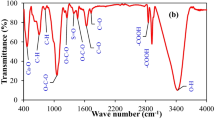Abstract
Biochar prepared from rice husk (rBC) was used as a nanosorbent for the sustained delivery of 2,4-dichlorophenoxyacetic acid (2,4-D) and for its potential use as an eco-friendly nanoherbicide formulation. For the biochar-based 2,4-D nanoformulation (DrBC), the loading efficiency of the herbicide onto the rBC nanocarrier was checked at various weight ratios, where a weight ratio of 1:0.25 (rBC:2,4-D) was found optimum. Further experiments were carried out to understand the 2,4-D sorption characteristics of rice husk biochar (rBC) and its sustained herbicidal release property in soil and water. When the adsorption mechanism was analyzed, the Freundlich isotherm and pseudo-second-order kinetic equation were found to be the best. The sustained release of 2,4-D from the DrBC nanoformulation was detected for about 26 days. The release profile of 2,4-D from DrBC was found to be a controlled diffusion mechanism based on Korsmeyer–Peppas model fit. The size of the DrBC nanoformulation was found to be 256.5 nm using dynamic light scattering (DLS) with a negative zeta potential of 28.8 mV. Fourier transform infrared spectroscopy (FT-IR) results indicated the involvement of carboxyl, aromatic carbon, and siloxane in 2,4-D adsorption onto rBC. The additional chlorine in the EDAX spectrum of scanning electron microscope (SEM) indicated the herbicide adsorption onto the rBC carrier. The DrBC nanoformulation exhibited enhanced herbicidal activity against the tested Brassica sp., but did not affect the growth of the non-target plant (Zea mays). The present study could be promising for achieving high herbicidal loading, sustained release, and reduced leaching of 2,4-D for its effectual usage in an eco-friendly fashion.







Similar content being viewed by others
References
Abdulrazzaq H, Jol H, Husni A, Abu-Bakr R (2014) Characterization and stabilisation of biochars obtained from empty fruit bunch, wood and rice husk. Bioresources 9(2):2888–2898
Dotto GL, Cadaval TRS, Pinto LAA (2012) Use of spirulina platensis micro and nanoparticles for the removal synthetic dyes from aqueous solutions by biosorption. Process Biochem 47:1335–1343
Dubinin MM (1960) The potential theory of adsorption of gases and vapors for adsorbents with energetically non uniform surface. Chem Rev 60:235–266
Foo LPY, Tee CZ, Raimy NR, Hassell DG, Lee LY (2012) Potential Malaysia agricultural waste materials for the biosorption of cadmium(II) from aqueous solution. Clean Tech Environ Policy 14:273–280
Freundlich HMF (1906) Over the adsorption in solution. J Phys Chem 57:385–470
Langmuir I (1918) The adsorption of gases on plane surfaces of glass, mica and platinum. J Am Chem Soc 40:1361–1403
Lingamdinne LP, Roh H, Choi YL, Koduru JR, Yang JK, Chang YY (2015) Influencing factors on sorption of TNT and RDX using rice husk biochar. J Ind Eng Chem, Ind. https://doi.org/10.1016/j.jiec.2015.08.012
Ma L, Peng Y, Wu B, Lei D, Xu H (2013) Pleurotus ostreatus nanoparticles as a new nano-biosorbent for removal of Mn (II) from aqueous solution. Chem Eng J 225:59–67
Mohan D, Sarswat A, Ok YS, Pittman CU (2014) Organic and inorganic contaminants removal from water with biochar, a renewable, low cost and sustainable adsorbent: a critical review. Bioresour Technol 160:191–202
Pereira AES, Grillo R, Mello NFS, Rosa AH, Fraceto LF (2014) Application of poly(epsilon-caprolactone) nanoparticles containing atrazine herbicide as an alternative technique to control weeds and reduce damage to the environment. J Hazard Mater 268:207–215
Qian K, Shi T, Tang T, Zhang S, Liu X, Cao Y (2011) Preparation and characterization of nano-sized calcium carbonate as controlled release pesticide carrier for validamycin against Rhizoctonia solani. Microchim Acta 173:51–57
Sivasamy A, Nethaji S, Nisha LLJL (2012) Equilibrium, kinetic and thermodynamic studies on the biosorption of reactive acid dye on Enteromorpha flexuosa and Gracilaria corticata. Environ Sci Pollut Res 19:1687–1695
Sun X, Shan R, Li X, Pan J, Liu X, Deng R, Song J (2017) Characterization of 60 types of Chinese biomass waste and resultant biochars in terms of their candidacy for soil application. GCB Bioenerg 9:1423–1435
Tang L, Zhang S, Zeng GM, Zhang Y, Yang GD, Chen J, Wang JJ, Zhou YY, Deng YC (2015) Rapid adsorption of 2,4-dichlorophenoxyacetic acid by iron oxide nanoparticles-doped carboxylic ordered mesoporous carbon. J Colloid Interf Sci 445:1–8
Temkin MJ, Pyzhev V (1940) Recent modifications to Langmuir isotherms. Acta Phys Chim Sin 12:217
Vaccari FP, Baronti S, Lugato E, Genesio L, Castaldi S, Fornasier F, Miglietta F (2011) Biochar as a strategy to sequester carbon and increase yield in durum wheat. Eur J Agron 34:231–238
Xu X, Cao X, Zhao L (2013) Comparison of rice husk- and dairy manure-derived biochars for simultaneously removing heavy metals from aqueous solutions: role of mineral components in biochars. Chemosphere 92:955–961
Yan Y, Hou H, Ren T, Xu Y, Wang Q, Xu W (2013) Utilization of environmental waste cyanobacteria as a pesticide carrier: studies on controlled release and photostability of avermectin. Colloid Surf B 102:341–347
Acknowledgements
The authors would like to thank the Hindustan University management for the support and the VIT University, Vellore for helping in instrumental analysis.
Author information
Authors and Affiliations
Corresponding author
Ethics declarations
Conflict of interest
The author would like to declare that there exists no conflict of interest.
Rights and permissions
About this article
Cite this article
Evy Alice Abigail, M. Biochar-based nanocarriers: fabrication, characterization, and application as 2,4-dichlorophenoxyacetic acid nanoformulation for sustained release. 3 Biotech 9, 317 (2019). https://doi.org/10.1007/s13205-019-1829-y
Received:
Accepted:
Published:
DOI: https://doi.org/10.1007/s13205-019-1829-y




